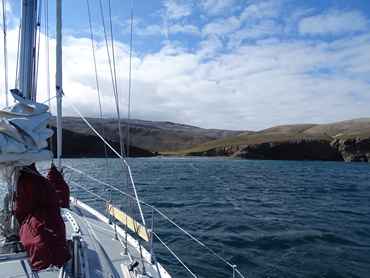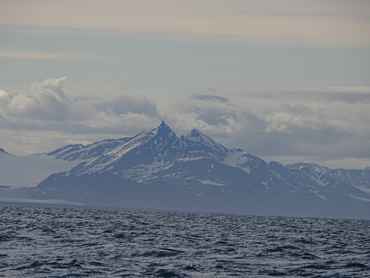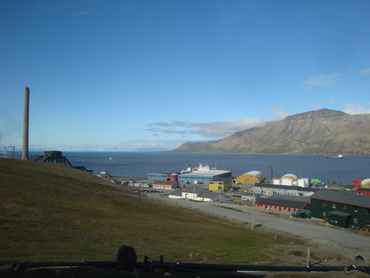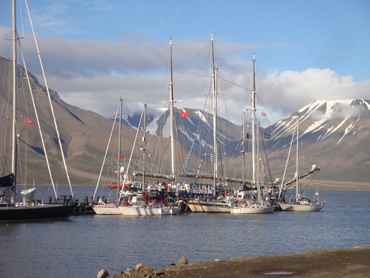Our arrival in Svalbard

Rosinis heads to Svalbard
Bob Hendicott
Wed 18 Jul 2018 10:32
|
We’ve been in Svalbard since the day before yesterday and are currently in
Longyearbyen, the administrative centre, where we had to check in, finalise
permits to go elsewhere, and hire a rifle and ammunition as a precaution against
polar bears.
Before we departed from Bjornoya we had another attempt at fixing the
outboard motor. It was now Sat 14th Jul. A long wrench managed to
free the seizure which can have been nothing more than light rust, but we
couldn’t get fuel into the combustion chamber despite trying all the normal
tricks. Running out of options, we opened up the crank case to find it
full of rust and gunge. Somehow either water or very damp air had got
in. With some careful cleaning and use of cable ties as ‘chimney brushes’
to poke through the fuel ducts we improved things significantly. On
re-assembly we warmed up the spark plug on the galley stove, stood the engine in
a bucket of water in the cockpit, and you’d be hard pressed to imagine our joy
when it started and continued to run. This was a significant success, as
without an outboard we would not be able to get ashore in Svalbard as bears can
comfortably ‘out-swim’ a dinghy being rowed. The outboard is now wrapped
up in ‘an outboard cover-for-life’ courtesy of Tesco!
Elated, we had lunch and set sail for Svalbard; 120nm NNW to Sorkapp, its
southern tip, and another 140nm on to Isfjorden, leading to Longyearbyen.
Most of the passage was in very poor visibility, with either drizzle or fog, but
the wind came and went and we had good sailing interspersed by periods of
motoring. Most of the time we were below decks keeping as warm as we
could, and dry. At 1710 on Sun 15th we had a brief glimpse of snow and
mountains below cloud 8nm on our starboard beam, but within minutes the fog
closed in again and it was another couple of hours before we saw the shore
again. Then more fog and drizzle. At 0430 the water shoaled
significantly to around 25m and we saw high cliffs and jagged reefs on our
starboard bow. Our attempts to close the shore had been a little too
enthusiastic and we headed NW again into deeper water, with the wind gradually
building, but from dead ahead. Soon we were sailing fast, beating up the
coast, and as we tacked back to the north we suddenly burst into clear
conditions, with strong sun and blue sky. Closing the coast we faced the
most magnificent panorama: to the north the dark mountains of Prins Karls
Forland, to the NW the mountains and glaciers running north from Isfjorden, and
to the SW a similar view running back down the coast we’d just sailed up.
Ahead of us was the broad opening of Isfjorden which runs deep into the west
side of Spitsbergen, Svalbard’s largest island, and we sailed in at good speed,
in awe of the view. Wanting a closer look, we decided to divert into the
first fjord on our left as we headed in towards Longyearbyen, an inlet about 4
nm long called Trygghamna with two glaciers at its head and impressive mountains
either side. By now it was late afternoon but we spent a couple of hours
there, spotting our first Svalbard reindeer on the shore. Then it was
sails up again to head across to Longyearbyen, which looked close but the light
is so clear that distances are deceptive and it took us until just after
midnight (albeit still in bright sunlight) to get there in a brisk following
breeze. We worked out that we’d earlier been looking 40nm in each
direction up and down the coast. Many of the glaciers appear to be in
retreat: a sad reminder in this arctic desert of the impact of global
warming.
After a quick look at alongside mooring arrangements in Longyearbyen we
decided to anchor off, and spent until 0200 sitting in the cockpit under
relatively warm sunlight celebrating our arrival, amazed at how lucky we’d been
with the weather for the past 12 hours: such a contrast to the preceding 4
days. Yesterday we moved alongside, fuelled and watered, then ploughed
through essential bureaucracy. It all went smoothly, but we were surprised to
find that the reserved rifle wasn’t quite as reserved as we’d expected. We
took the last available weapon, a vintage Mauser 30-06 left behind after WW II,
pondering on the potential nuisance if we’d left it another day, as local
regulations mean we couldn’t have left Longyearbyen until one came
available. We enjoyed an excellent meal ashore last night at a sensible
price: Svalbard is wholly duty free, which appears to more than compensate for
the cost of transporting goods in. Our diesel was the cheapest I’ve bought
for 7 years, at an equivalent of £0.86/litre, but it’s a long way to come to top
up: just over 2400nm since leaving the Solent.
The weather has continued to hold and as I write this early on Wed 18th,
we’ve now had over 36 hours of continuous bright sunshine, but with a biting
wind. Today we’ll do some more exploring of Longyearbyen, top up our fresh
provisions and prepare to head on. Our plan is to explore the NW coast as
far as 80N, just 600nm from the North Pole. This morning’s ice report
shows the polar ice front 90nm further north than that and the coast completely
free of sea ice. We’ll still need to be wary of ice calved off glaciers in
the fjords, but all’s looking good.
Attached photos show Kvallrossbukta and the cliffs on Bjornoya; our first
glimpse of Svalbard; us heading into Isfjorden; Trygghamna and our passage into
Isfjorden; early hours of the morning crew arrival photo at anchor off
Longyearbyen (shades on in the midnight sun – yes, seriously required!), and a
couple of views of Longyearbyen – out to sea and our moorings, where we’re the
smallest yacht by some margin.
Fauna watch: ashore in Longyearbyen we discovered three huskies chained up,
merrily howling away, one was a large Greenland husky and two were smaller
Alaskans. Despite the wolf like features they were extremely
friendly. The two Arctic Terns in town were not. Walking back to the
boat after our initial look around we were suddenly attacked with the birds
diving and squawking at our heads. They could easily have done some damage
but six frantic arms waving in the air saw them off (or more likely we simply
moved away from their nest site next to the road). Most things around here
are the most northerly in the world not least the two little black and white
snow buntings we saw, one of only two species of land bird in Svalbard.
Iso and Hector - Daddy here, it is very cold... I am wearing my
hat with furry ears, but keep getting the earflap buttons caught in the nets
that hold the vegetables inside. Then I need to be rescued a bit like a
fish! |








